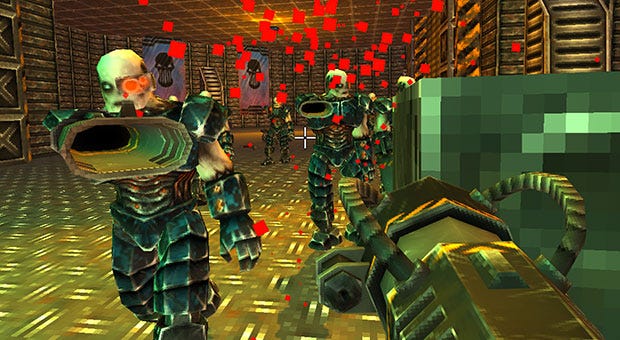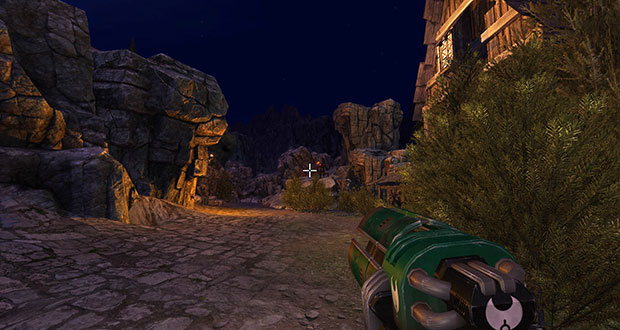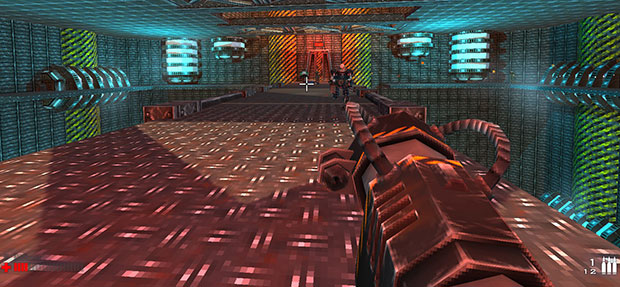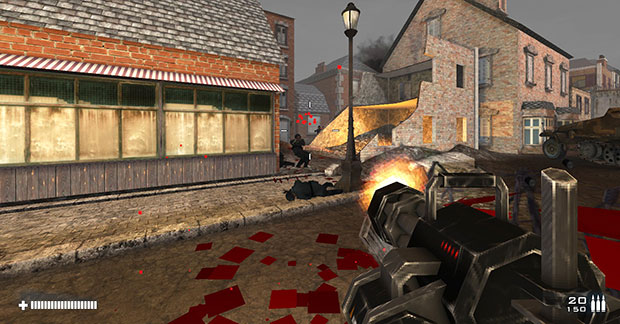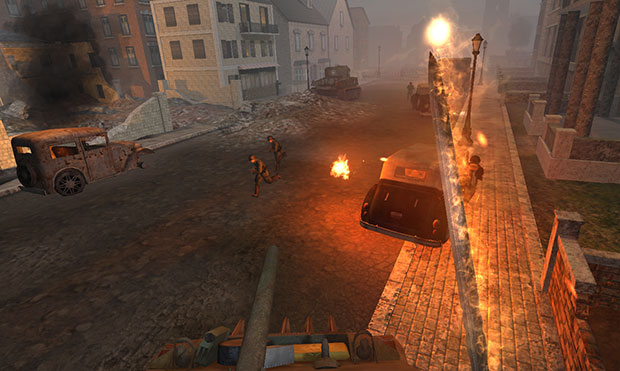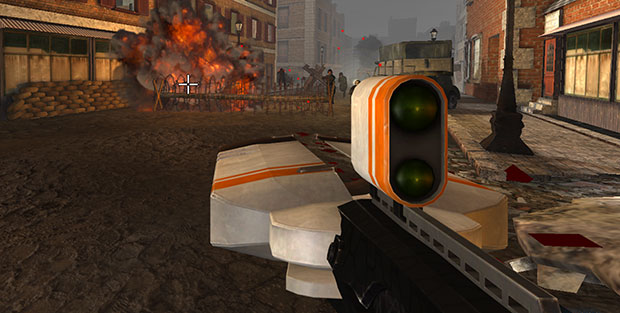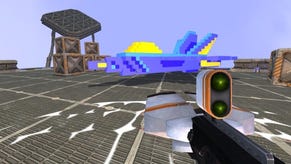Hands-On With Bedlam, The FPS About FPSes
From Quake II to Call of Duty and beyond
I'm rocket-jumping over Helm's Deep. I'm pinning Nazis to 1940s French churches with catapult bolts. I'm shooting Strogg-homages in metal corridors with a chunky, low-res shotgun, and frankly that much Quake IIiness is enjoyable enough in and of itself that it doesn't need any era-mixing funny business anyway. I'm finding glitches that transport me - and whichever weapons I've accrued - across and through a brief history of first-person shooters, with occasional sidetrips to other eras and genres of gaming.
I'm a gun on legs, because Bedlam is a game all about shooting games that were comfortable with being just that, and about a time when the world accepted they were just that, before cutscenes and quick-time events were put in place to pretend there was something more going on in shooting games than just that.
Perhaps there is meta-commentary about shooters, but Bedlam's certainly not trying to Do A BioShock. It's trying to be more of a love letter to the earlier, more innocent years of what is perhaps the defining videogame genre. Or, at least, the most lucrative and notorious genre. Based on the book of the same name by Scottish author Christopher Brookmyre (diverting from his usual crime fare into sci-fi), this echoes and tries to recreate his clear love of pre-Modern Warfare FPS.
While the novel didn't really work for me - I felt it tried to do too many things at once, especially tonally - the sections wherein it attempted to describe what a Quake II map (and its AI characters) would look and feel like in reality worked well. And, conceptually speaking, the idea of a game protagonist skipping through the ages of virtual gunplay is an excellent one, and it's that concept that Bedlam the game most concerns itself with.
I played a few levels of a pre-Early Access build earlier this week, and must note at this point that what I played is indeed very early. It also boasts neither the budget or price tag (it'll be £12.99 when it hits Early Access on 8 Aug) of a contemporaneous Patriotic Soldier Man or Universe-Saving Space Marine title. I don't want to spoil all the games it homages, but it does run closer to the present day than the stuff I've mentioned already.
That means more up-to-date graphics than the consciously retro fare you can see in these screens. There's also a Tronish bridge-world between games/eras, sometimes accessed as part of level progression, but sometimes entered via a 'glitch' and housing secret, agreeably inappropriate weaponary. Hence, Quake II - sorry, Starfire - with a crossbow or Call of Duty - sorry, Death or Glory - with a remote-detonating grenade launcher.
While the graphics, level design, weapons and enemies might change (although the latter two do bleed between eras at certain points), something that doesn't is the player's abilities and movement. I was a little surprised by the latter, as throughout their long and bloody history, movement has been arguably more important to shooters than the shooting has. The movement in an early Quake is very different to the movement in an early Medal of Honor, which is very different to the movement in a latter-day shooter. Developers Red Bedlam have, however, opted to make the player character move in the way a contemporaneous FPS protagonist would, regardless of which era they're currently visiting. They want consistency and they want relative modernity of feel, even if much of the scenery is conscious retro-homage.
There are two particular ways, beyond the merely visual, in which Bedlam tries to show us how different - and how enjoyable - Old Man Shooter was back in his blocky youth. One is, as I've already mentioned, rocket-jumping. Rarely seen outside of Team Fortress 2 these days, this iconic and semi-lethal nugget of emergent gaming gets to play a role in a singleplayer campaign. During my visit, the developers were wondering aloud over just how far a rocket-jump could hurl an adept player, fearful that it could see people soaring to level exits within seconds.
I opined that this wasn't necessarily a bad thing as, thanks to the boost distance in the build I was playing being set to basically 'outer orbit', I was several hundred feet above a Tolkien-esque fantasy town at the time, but it's fair enough that the team would want people to actually see what they'd made. I'm pretty sure Bedlam will wind up being a gifthorse for speedrunners whatever the devs settle on, though.
The other more-than-skin-deep exploration of older shooter values in Bedlam is the level design. The Starfire sections, for instance, switch between the steel corridors of early id games to the multi-tier jumpad-filled arenas of Quake III and even the vertiginous zero-G of Unreal Tournament's Facing Worlds. The World War II 'Death or Glory' levels, meanwhile, have sniper-filled European apartment blocks to sprint through, and dangerously open plazas - y'know, the changing beats of olden CoDs and MoHs. All that said, sprinting and constant shooting are the order or the day, even though height and cover and buildings are there if you want them.
Whatever the locale and whether you're wielding a Luger, laser rifle or fireball-spewing sword, there's one constant - almost cutscene-free plot and dialogue from protaognist Athena, a foul-mouthed, pun-loving Scottish lady who's found herself Tronified into a computer game, then summarily dragged off into other ones still. There'll be professional voice-acting added later on, but used for placeholder speech in the build I played was Christopher Brookmyre himself. Never mind that he's not a woman, he sounds a hell of a lot like Peter Capaldi, and that coupled with the proliferation of cheerful obscenities had me feeling I was playing Malcolm Tucker Does Quake. I hope to God they keep the Brookmyre recordings in there as an Easter egg, no matter what they wind up doing with the proper voices.
Clearly, Bedlam's trying to bite off an awful lot. What I played was very early, and when it takes to Early Access on August 8th it's certainly a case of only having so much done, with only so much polish, rather than one of those that tries to squeak out a couple of weeks of free QA while the team's busy squashing the last few release candidate bugs. About the first third of the game will be playable, comprising the Starfire and Death Or Glory sections, and that's a good few hours of time-hopping alien'n'Nazi-shooting, but what I saw needs a fair bit of work on optimisation, AI and assorted buffing up. Early Access is as Early Access does.
The concept's great, the modernised old school weapons feel good, it's drenched with enthusiasm, and the no mess, no fuss approach to shooters is refreshing, and as someone who's lived through all these huge changes to the shooter formula it's damned exciting to see the timeline play out a high speed. There's a lot of work left to be done though, and I do need to see how it evolves over the next few months before I'm pointing my thumbs in any one direction.
Bedlam, from Brighton developers Red Bedlam (confusing, innit?) is out on Early Access on Aug 8th, for £12.99. Full release date is TBC.
